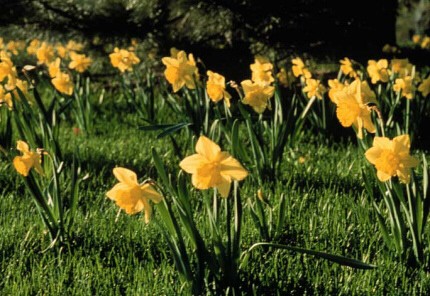Turf & Lawn Blog
Naturalising bulbs in lawns
From early September until the end of October or early November is the best time to plant spring bulbs. So how about planting some in your lawn? They will naturalise over time, and become a key part of your spring garden, brightening the place up with their cheerful colour. Adding bulbs to the lawn is a very good way to get additional spring colour into a garden where there isn’t much space for bulbs in the garden beds, or just to add an accent of colour in the middle of all that green.

So what sort of bulbs are suitable, and what do you need to do to plant them?
Almost any sort of bulbs are suitable. Early bulbs like snowdrops, crocus and dwarf iris will have finished flowering and the leaves died back by the time you want to start mowing your lawn in late spring. However, the leaves of daffodils and tulips will not yet have died down by the first mowing, so you will need to leave the bulb patch unmown for a while. This may or may not suit you, which could dictate your choice of bulbs!
A suitable place is often where the lawn turf is a bit sparser, perhaps under a tree. Since deciduous trees won’t be in leaf when spring bulbs are flowering, they won’t be affected by the shade. But almost anywhere is suitable, and if you really want, you could fill the whole lawn with spring bulbs.
For a natural look, it’s generally recommended that you scatter the bulbs around on the turf, and just plant them where they land. You can buy bulb planters, but I’ve never found them much good, as they’re not really sharp enough. Instead, I find a good trowel is better, and a long thin one better still. If you’re planting in the middle of your beautiful lawn, cut the turf in an H shape with a garden spade, and lift it back. Dig a hole about 2 ½ times deeper than the bulb and drop the bulb in with the roots downwards. You can probably plant four or five bulbs into each H. It can be helpful to drop in a little compost into each hole as well, just to give the bulbs a bit of additional ‘oomph’.
Carefully replace the turf, pressing down the edges, and water. Where there isn’t much grass, such as under a tree, you can just dig holes, but your turf may look a bit battered by the end.
And finally, in spring, don’t forget to let the bulb leaves to die back naturally before you mow them, as otherwise the bulbs will not be able to flower again next year.
When you subscribe to the blog, we will send you an e-mail when there are new updates on the site so you wouldn't miss them.
